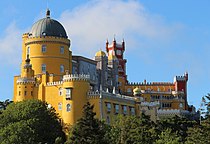Manueline
This article includes a improve this article by introducing more precise citations. (September 2018) ) |
The Manueline (
The style was given its name, many years later, by
Although the period of this style did not last long (from 1490 to 1520), it played an important part in the development of Portuguese art. The influence of the style outlived the king. Celebrating the newly maritime power, it manifested itself in architecture (churches, monasteries, palaces, castles) and extended into other arts such as sculpture, painting, works of art made of precious metals, faience and furniture.
Characteristics

This decorative style is characterized by virtuoso complex ornamentation in portals, windows, columns and arcades. In its end period, it tended to become excessively exuberant as in Tomar.
Several elements appear regularly in these intricately carved stoneworks:
- elements used on ships: the armillary sphere (a navigational instrument and the personal emblem of Manuel I and also a symbol of the cosmos), spheres, anchors, anchor chains, ropes and cables.
- elements from the sea, such as shells, pearls and strings of seaweed.
- botanical motifs such as laurel branches, oak leaves, acorns, poppy capsules, corncobs, and thistles.
- symbols of Christianity such as the cross of the Order of Christ(former Knights Templar), the military order that played a prominent role and helped finance the first voyages of discovery. The cross of this order decorated the sails of the Portuguese ships.
- elements from newly discovered lands (such as the tracery in the Royal Cloister of the Batalha Monastery, suggesting Islamic filigree work, influenced by buildings in India)
- columns carved like twisted strands of rope
- semicircular arches (instead of Gothic pointed arches) of doors and windows, sometimes consisting of three or more convex curves
- multiple pillars
- eight-sided capitals
- lack of symmetry
- conical pinnacles
- bevelled crenellations
- ornate portals with niches or canopies.
Examples

When King Manuel I died in 1521, he funded 62 construction projects. However, much original Manueline architecture in Portugal was lost or damaged beyond restoration in the

Outside Lisbon, the church and chapter house of the Convent of Christ at Tomar (designed by Diogo de Arruda) is a major Manueline monument. In particular, the large window of the chapter house, with its fantastic sculptured organic and twisted rope forms, is one of the most extraordinary achievements of the Manueline style.
Other major Manueline monuments include the arcade screens of the Royal Cloister (designed by
Other remarkable Manueline buildings include the church of the
The style was extended to the decorative arts and spread throughout the Portuguese Empire, to the islands of the Azores, Madeira, enclaves in North Africa, Brazil, Goa in Portuguese India and even Macau, China. Its influence is apparent in southern Spain, the Canary Islands, North Africa and the former Spanish colonies of Peru and Mexico.
Famous Manueline artists
Architects
Painters
- Vasco Fernandes
- Jorge Afonso
- Cristóvão de Figueiredo
- Garcia Fernandes
- Gregório Lopes
Gallery

-
Doorway at the University of Coimbra
-
Doorframe in a church in Elvas
-
Doorframe of a church in Golegã
-
Royal palace at Évora
-
Royal palace at Évora, gallery
-
Manueline furnishings of a 16th century Portuguese countryside house
-
Manueline windowframe in Pinhel
-
Windowframe in Évora
-
"Bicephalous Fountain", displaying both the heads of King Manuel and the Queen, and an armillary sphere, the royal emblem
-
Decorative motifs in the Monastery of Tomar
-
Cloyster at the Batalha monastery
-
Detail of decorative motifs in the Batalha Monastery
-
Monastery of Batalha
-
Chapel inBelém, Lisbon
-
Detail of the chapel in Belém
-
Castle of Alvito, with Manueline elements
-
Sempre Noiva manor
-
Manor of the Henriques de Trastámaras, in Alvor
See also
- Neo-Manueline
- Portuguese Architecture
References
Manueline architecture.
- Atanázio, A Arte do Manuelino, Lisbon, Presença, 1984.
- Turner, J., ISBN 0-19-517068-7
- The Rough Guide to Portugal, March 2005, 11th edition, ISBN 1-84353-438-X
- Smith, Robert C., The Art of Portugal 1500-1800; Weidenfeld & Nicolson, London, 1968 ISBN 0-297-76096-3





















